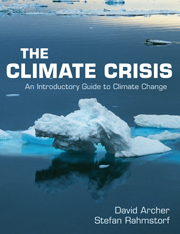Book contents
- Frontmatter
- Contents
- Preface
- 1 Retrospective: what we knew and when we knew it
- 2 Earth's energy budget
- 3 Climate change so far
- 4 Snow and ice
- 5 How the oceans are changing
- 6 The past is the key to the future
- 7 What the future holds
- 8 Impacts of climate change
- 9 Avoiding climate change
- 10 Climate policy
- Epilogue
- References
- Illustration credits
- Index
3 - Climate change so far
Published online by Cambridge University Press: 05 March 2013
- Frontmatter
- Contents
- Preface
- 1 Retrospective: what we knew and when we knew it
- 2 Earth's energy budget
- 3 Climate change so far
- 4 Snow and ice
- 5 How the oceans are changing
- 6 The past is the key to the future
- 7 What the future holds
- 8 Impacts of climate change
- 9 Avoiding climate change
- 10 Climate policy
- Epilogue
- References
- Illustration credits
- Index
Summary
When people think of climate change, they usually think of the atmosphere first. They think of the kind of things they hear about in the weather forecast: air temperature, rainfall, winds. Professional climatologists usually have a more encompassing view of the climate system, which includes things like the oceans, the ice sheets and mountain glaciers. But let's go step by step and start with the atmosphere, and let's start by taking stock of what is actually happening there. Many people feel that significant changes are underway – that winters are not what they used to be in their childhood, or perhaps that summers never used to be so hot and dry in their region. While these are often valid observations, any single person's experience is necessarily rather limited to the region where they live and to what they can remember. So what do measurements from around the world show? That is what we will discuss in this chapter.
With each IPCC report, the picture is getting ever more clear. There is an obvious reason for this: since the first report in 1990, we have accumulated 17 more years of measurements. But in addition to that, a lot of work has been done on the quality control and a comprehensive analysis of errors in past measurement data sets, on filling gaps and on recovering data archives that had not yet been included, for example because they existed only on paper and not yet in digital format.
- Type
- Chapter
- Information
- The Climate CrisisAn Introductory Guide to Climate Change, pp. 39 - 67Publisher: Cambridge University PressPrint publication year: 2009
- 1
- Cited by



